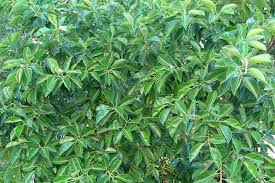Rubber Plant
Friday, April 25, 2025

Common Names:
- Rubber Tree
- Rubber Plant
- Indian Rubber Tree
- Fig Tree
Family:
Moraceae (Mulberry family)
Native Region:
Southeast Asia, particularly India, Nepal, Bhutan, Myanmar, and Malaysia.
Plant Description:
- Size: Up to 100 feet (30 meters) outdoors, 6–10 feet (1.8–3 meters) indoors.
- Leaves: Glossy, oval-shaped, deep green. Some cultivars are variegated.
- Stem/Trunk: Thick, woody trunk as it matures.
- Flowers: Rarely flowers indoors; produces syconium in native environments.
Care Requirements:
Light:
- Bright, indirect light is ideal.
- Avoid direct sunlight to prevent scorching.
Watering:
- Water when top 1–2 inches of soil are dry.
- Avoid overwatering and soggy soil.
- Mist leaves or use a humidity tray in dry air.
Temperature:
- Preferred: 60–75°F (15–24°C).
- Avoid drafts and temps below 50°F (10°C).
Soil:
- Use well-draining potting mix (soil + perlite + peat moss).
- Ensure pot has drainage holes.
Fertilization:
- Every 4–6 weeks during spring/summer with balanced fertilizer.
- Reduce to every 6–8 weeks in fall/winter.
Pruning:
- Encourages new growth and controls size.
- Use sharp scissors to cut leggy or damaged branches.
- Propagate with stem cuttings.
Repotting:
- Every 1–2 years or when root-bound.
- Choose a pot 1–2 inches wider.
- Check for root rot if growth slows.
Common Problems:
- Yellowing Leaves: Often caused by overwatering.
- Leaf Drop: Stress from low light or inconsistent watering.
- Brown Leaf Tips: Indicates low humidity or underwatering.
- Pests: May attract mealybugs, aphids, or spider mites. Treat with insecticidal soap or wipe leaves.
Toxicity:
Rubber plants contain a milky sap that can irritate skin and is mildly toxic if ingested. Keep away from pets and small children.
Propagating Rubber Plant:
Stem Cuttings:
Take a 4–6 inch cutting with leaves, dip in rooting hormone, plant in moist soil, and keep warm/humid.
Air Layering:
Encourage roots to grow on a branch before cutting and potting it separately.
Varieties and Cultivars:
- Ficus elastica 'Robusta': Classic dark green variety.
- Ficus elastica 'Variegata': Creamy white or pink-streaked leaves.
- Ficus elastica 'Tineke': Green and white marbled leaves.
Benefits:
- Air Purification: Removes toxins like formaldehyde from air.
- Aesthetic Appeal: Its glossy, bold foliage adds natural beauty indoors.
Conclusion:
The rubber plant (Ficus elastica) is a low-maintenance, stunning indoor plant. It thrives with proper light, watering, and temperature, growing into an elegant feature in any room. Its air-cleaning abilities and bold foliage make it a favorite among plant lovers and interior decorators alike.